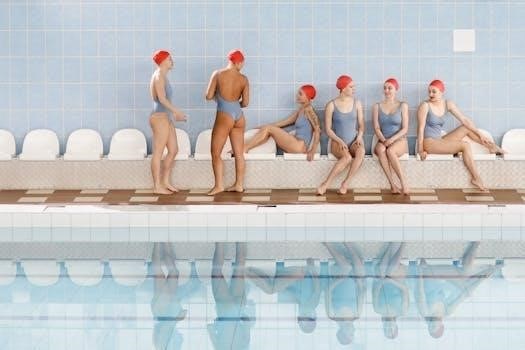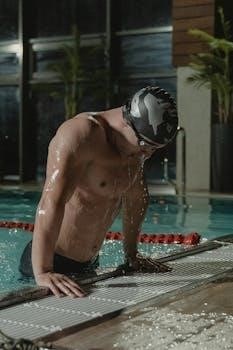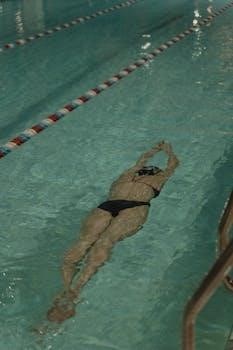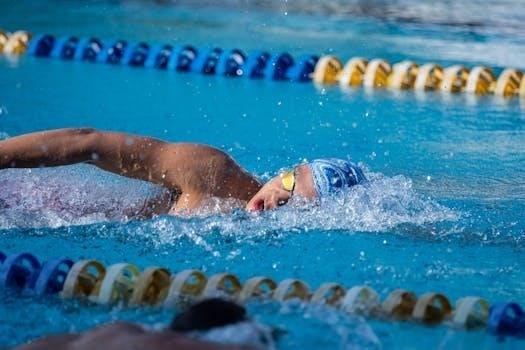Swimming Training Program for Beginners (PDF Guide)
Embark on your aquatic journey with our comprehensive swimming training program for beginners, conveniently available as a PDF guide. This resource offers structured workouts and expert tips designed to help you master the fundamentals and build confidence in the water.
Welcome to the world of swimming! This section introduces beginner swimming programs designed to provide a solid foundation for your aquatic journey. These programs are carefully crafted to guide individuals with little to no prior swimming experience, ensuring a safe and effective learning process. The primary focus is on developing essential skills and building confidence in the water.
Beginner swimming programs typically cover fundamental techniques such as floating, treading water, and basic stroke mechanics. The goal is to equip participants with the necessary tools to navigate the water comfortably and efficiently. These programs often incorporate drills and exercises that gradually increase in difficulty, allowing swimmers to progress at their own pace. Furthermore, safety is paramount, and participants will learn important water safety rules and emergency procedures.
Whether you aspire to swim laps for fitness, enjoy recreational swimming, or eventually participate in competitive events, a well-structured beginner swimming program is the ideal starting point. These programs provide a supportive environment where you can learn from qualified instructors and connect with fellow beginners, fostering a sense of camaraderie and motivation.
Key Focus⁚ Technique Over Speed
In the initial stages of learning to swim, the primary emphasis should be on mastering proper technique rather than striving for speed. Building a solid foundation of correct form is crucial for long-term progress and injury prevention. Prioritizing technique allows beginners to develop efficient movement patterns, which ultimately leads to faster swimming with less effort.
Focusing on technique involves paying close attention to body position, stroke mechanics, breathing, and overall coordination. It’s about understanding how each part of your body contributes to propulsion and minimizing resistance in the water. By perfecting these elements, you’ll create a more streamlined and effective swimming style.
While it’s natural to want to swim faster, attempting to increase speed before establishing proper technique can lead to bad habits and inefficient movements. These habits can be difficult to correct later on, hindering your progress and potentially causing strain or injury. Therefore, patience and a commitment to mastering technique are essential for beginner swimmers.
Remember, speed will naturally come as your technique improves. By focusing on the fundamentals and building a strong foundation, you’ll be well-equipped to progress to more advanced training and achieve your swimming goals.
Warm-up and Cool-down Importance
Incorporating a proper warm-up and cool-down into every swim training session is paramount, particularly for beginners. These phases prepare your body for the exertion of swimming and facilitate recovery afterward, minimizing the risk of injury and maximizing the benefits of your workout. Neglecting these critical components can lead to muscle soreness, stiffness, and increased susceptibility to strains or other ailments.
A well-structured warm-up gradually increases your heart rate, blood flow, and muscle temperature, enhancing flexibility and range of motion. It should include light cardiovascular activity, such as easy swimming or dynamic stretching exercises that mimic swimming movements. This prepares your muscles and joints for the demands of the workout, reducing the likelihood of strains and tears.
Conversely, a cool-down allows your body to gradually return to its resting state. It helps to flush out metabolic waste products, reduce muscle soreness, and prevent blood pooling. A cool-down typically involves gentle swimming, stretching, or other low-intensity activities.
By prioritizing warm-up and cool-down routines, beginner swimmers can optimize their performance, prevent injuries, and enhance their overall swimming experience. These practices are not merely optional add-ons but integral parts of a well-rounded training program.
Frequency and Duration of Training Sessions
Establishing a suitable frequency and duration for training sessions is crucial for beginner swimmers to ensure consistent progress without risking overexertion or burnout. The ideal approach involves finding a balance that aligns with individual fitness levels, goals, and time constraints. Starting with a moderate frequency and gradually increasing it as fitness improves is generally recommended.
For most beginners, aiming for 2-3 swimming sessions per week is a good starting point. This allows for sufficient recovery time between workouts, preventing muscle fatigue and reducing the risk of injury. Each session should last approximately 30-45 minutes, focusing on technique development, building endurance, and gradually increasing yardage.

It’s essential to listen to your body and adjust the frequency and duration of sessions accordingly. If you experience excessive fatigue, muscle soreness, or any signs of overtraining, reduce the number of sessions or shorten their duration. Rest and recovery are just as important as the training itself, allowing your body to adapt and rebuild.
As you progress and become more comfortable in the water, you can gradually increase the frequency and duration of your swimming workouts. However, it’s crucial to maintain a balanced approach, prioritizing proper technique and recovery to avoid plateaus and injuries.
Sample 6-Week Training Plan (3 Times Per Week)
This sample 6-week training plan is designed for beginner swimmers aiming to improve their fitness and technique, with three sessions per week. Each session incorporates a warm-up, main set, and cool-down, focusing on building endurance and refining stroke mechanics. Remember to consult your doctor before starting any new exercise program.
Week 1⁚ Focus on establishing a consistent routine. Each session includes 10 minutes of warm-up (easy swimming, drills), 20 minutes of main set (alternating freestyle and backstroke, short rest intervals), and 5 minutes of cool-down (easy swimming). The main set focuses on stroke technique.
Week 2⁚ Increase the intensity and duration of the main set. Warm-up remains the same. The main set now includes 25 minutes of freestyle and backstroke with moderate rest. Cool-down stays at 5 minutes.
Week 3⁚ Introduce new strokes and drills. Warm-up remains consistent. The main set now includes 30 minutes, incorporating breaststroke and butterfly drills. Cool-down stays at 5 minutes.
Week 4⁚ Focus on endurance. Warm-up remains consistent. The main set extends to 35 minutes, emphasizing longer continuous swims with minimal rest. Cool-down stays at 5 minutes.
Week 5⁚ Mix up the workouts with interval training; Warm-up remains consistent. The main set includes 40 minutes of high-intensity intervals followed by active recovery. Cool-down stays at 5 minutes.
Week 6⁚ Test your progress. Warm-up remains consistent. Swim a continuous 600-meter freestyle, focusing on maintaining proper technique. Cool-down stays at 5 minutes.
Yardage Progression (e.g., Starting with 1100 Meters)
A structured yardage progression is crucial for beginner swimmers to gradually build endurance and avoid injury. Starting with a manageable distance like 1100 meters allows for a comfortable introduction to regular training. This initial yardage should be approached with a focus on technique and consistency, rather than speed.
In the early weeks, prioritize mastering proper stroke mechanics and breathing techniques. Divide the 1100 meters into smaller sets, incorporating rest intervals to maintain form. For example, you might start with 4 x 25-meter swims with short rests, gradually increasing the distance and reducing the rest as your fitness improves. Drills can be incorporated to improve efficiency.
As you progress, gradually increase the total yardage by 10-15% each week. This gradual increase allows your body to adapt to the demands of swimming. Incorporate longer sets, such as 100-meter and 200-meter swims, with moderate rest intervals. Also, experiment with different stroke variations to improve overall fitness.
Remember to listen to your body and adjust the yardage as needed. Rest and recovery are essential for preventing overtraining and injuries. If you experience pain, reduce the yardage or take a break. The goal is to build a solid foundation for long-term swimming success.

As you become more comfortable, you can set goals for increasing your yardage further. But always remember to prioritize technique and consistency to reach your goals.
Incorporating Rest and Recovery
Rest and recovery are vital components of any swimming training program, especially for beginners. Adequate rest allows your body to repair muscle tissue, replenish energy stores, and adapt to the demands of training. Neglecting rest can lead to overtraining, fatigue, and increased risk of injury.
Schedule rest days into your training plan. Aim for at least one or two full rest days per week, where you avoid strenuous activity. On these days, focus on activities that promote relaxation, such as gentle stretching, yoga, or massage. These activities can help reduce muscle soreness and improve flexibility.
Prioritize sleep. Aim for 7-9 hours of quality sleep each night. Sleep is crucial for muscle recovery and overall well-being. Establish a consistent sleep schedule and create a relaxing bedtime routine. Avoid caffeine and alcohol before bed, as they can disrupt sleep.
Proper nutrition also plays a role in recovery. Consume a balanced diet rich in protein, carbohydrates, and healthy fats. Protein is essential for muscle repair, while carbohydrates replenish energy stores. Stay hydrated by drinking plenty of water throughout the day.
Listen to your body and adjust your training plan as needed. If you feel excessively tired or sore, take an extra rest day or reduce the intensity of your workouts. Don’t push yourself too hard, especially when you are just starting. Remember that rest and recovery are just as important as the training itself.
Understanding Swimming Etiquette
Swimming etiquette ensures a safe and enjoyable experience for everyone sharing the pool. As a beginner, understanding these unspoken rules is crucial for fostering a positive environment. Before diving in, be mindful of others and their space.
Always enter the pool feet first, especially in crowded areas, to prevent collisions. Observe the lane designations; fast lanes are typically for experienced swimmers, while slower lanes accommodate beginners and those focusing on technique. Choose a lane that matches your pace and skill level.

When passing another swimmer, do so carefully and respectfully. Gently tap their foot to signal your intention to pass, and then overtake them smoothly, providing ample space. Avoid swimming directly in front of or behind another swimmer, as this can create an uncomfortable or disruptive experience.
If you need to stop or rest, move to the side of the lane to avoid obstructing other swimmers. Be mindful of your lane mates and avoid excessive splashing or creating waves that could interfere with their swim. Be considerate of others by refraining from loud conversations or disruptive behavior.
Follow any posted pool rules and regulations, which may include guidelines on equipment usage, lane direction, and appropriate conduct. Respect the lifeguard’s instructions and maintain a safe and courteous attitude at all times. By adhering to these simple principles, you contribute to a harmonious and enjoyable swimming experience for all.
Essential Swimming Equipment for Beginners
Starting your swimming journey requires a few essential pieces of equipment to ensure comfort, safety, and efficient training. The first and foremost item is a well-fitting swimsuit. Choose a suit designed for swimming, offering streamlined movement and minimal drag. For women, options include one-piece suits or athletic bikinis, while men can opt for swim briefs or jammers.
Goggles are crucial for protecting your eyes from chlorine and providing clear vision underwater. Look for goggles with a comfortable fit and adjustable straps to prevent leaks. Tinted lenses are ideal for outdoor swimming, while clear lenses are suitable for indoor pools.
A swim cap helps to keep your hair out of your face and reduces drag in the water. Silicone or latex caps are popular choices, offering a snug and secure fit. For those with long hair, consider using a hair tie to keep it contained beneath the cap;
While not strictly essential, a kickboard can be a valuable tool for isolating your leg muscles and improving your kick technique. Choose a kickboard that is comfortable to grip and provides adequate buoyancy. Fins can also be helpful for developing leg strength and improving propulsion.
Finally, a towel is a must-have for drying off after your swim. Opt for a quick-drying and absorbent towel that is easy to pack and carry. With these essential pieces of equipment, you’ll be well-prepared to begin your swimming training program with confidence and comfort.
Goal Setting⁚ Aiming for 600m Completion
Setting achievable goals is crucial for staying motivated and tracking progress in your swimming journey. For beginners, a realistic and rewarding goal is to aim for the completion of a 600-meter swim. This distance provides a tangible target to work towards, offering a sense of accomplishment while building endurance and technique.
To effectively reach this goal, break it down into smaller, more manageable steps. Start by assessing your current swimming ability and gradually increase the distance you swim in each session. Begin with shorter intervals, such as swimming 50 meters followed by a brief rest, and progressively extend the intervals as your fitness improves. Consistency is key, so aim to swim regularly, even if it’s just for short periods.
Focus on maintaining proper technique throughout your swim, prioritizing form over speed. As you become more comfortable in the water, gradually increase the number of laps you swim without stopping. Incorporate rest periods as needed to avoid overexertion and allow your body to recover.
Track your progress by recording your swim times and distances. This will help you monitor your improvement and stay motivated. Celebrate your milestones along the way, and don’t be discouraged by setbacks; With dedication and perseverance, you’ll be well on your way to achieving your goal of completing a 600-meter swim.
Importance of Medical Clearance
Before embarking on any new exercise program, particularly swimming, obtaining medical clearance from a qualified healthcare professional is of paramount importance. This is especially crucial for individuals who have pre-existing health conditions, such as cardiovascular issues, respiratory problems, musculoskeletal ailments, or any other medical concerns. A thorough medical evaluation can help identify potential risks and ensure that the swimming program is tailored to your specific needs and limitations.

Medical clearance involves a comprehensive assessment of your overall health status, including a review of your medical history, a physical examination, and potentially diagnostic tests such as an electrocardiogram (ECG) or blood work. This evaluation helps determine whether swimming is a safe and appropriate activity for you, and whether any modifications or precautions are necessary.
Your healthcare provider can provide valuable guidance on how to safely incorporate swimming into your fitness routine, taking into account your individual health profile. They can also advise you on any potential risks associated with swimming, such as exertion-related complications or interactions with medications. By obtaining medical clearance, you can minimize the risk of injury or adverse health events and ensure that you can enjoy the benefits of swimming safely and effectively. Remember, your health and well-being should always be the top priority.